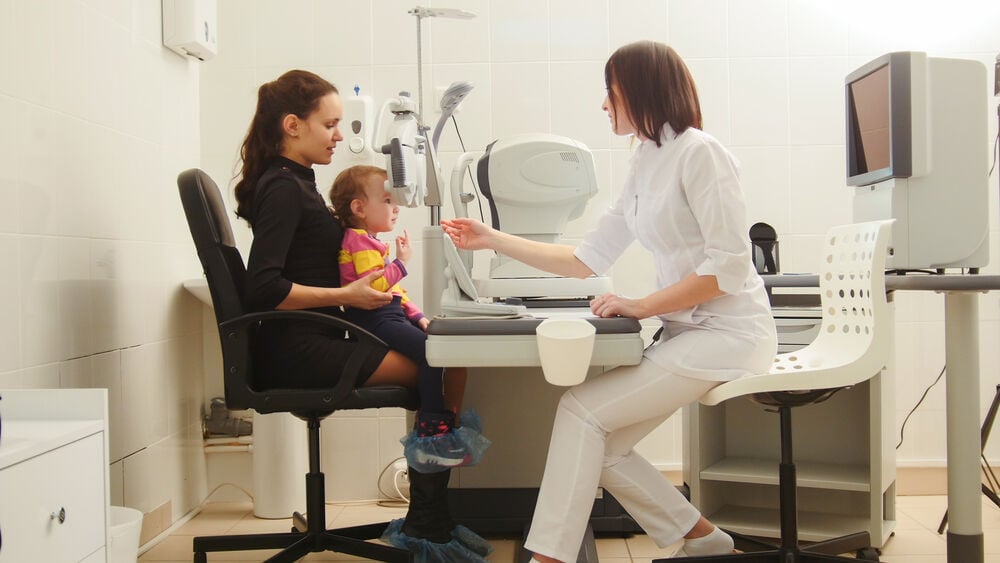-
Tracking cycle
-
Getting pregnant
-
Pregnancy
-
Help Center
-
Flo for Partners
-
Anonymous Mode
-
Flo app reviews
-
Flo Premium New
-
Secret Chats New
-
Symptom Checker New
-
Your cycle
-
Health 360°
-
Getting pregnant
-
Pregnancy
-
Being a mom
-
LGBTQ+
-
Quizzes
-
Ovulation calculator
-
hCG calculator
-
Pregnancy test calculator
-
Menstrual cycle calculator
-
Period calculator
-
Implantation calculator
-
Pregnancy weeks to months calculator
-
Pregnancy due date calculator
-
IVF and FET due date calculator
-
Due date calculator by ultrasound
-
Medical Affairs
-
Science & Research
-
Pass It On Project New
-
Privacy Portal
-
Press Center
-
Flo Accuracy
-
Careers
-
Contact Us
Cross-Eyed Babies: What Is Strabismus Treatment?

Every piece of content at Flo Health adheres to the highest editorial standards for language, style, and medical accuracy. To learn what we do to deliver the best health and lifestyle insights to you, check out our content review principles.
What is strabismus?
Strabismus is an eye disorder in which both of your baby's eyes don’t line up or look in a similar direction. They may wander up, down, in, or out and don’t look at or focus on the same thing or object at a given point of time. The eyes of your baby may turn:
- Outward (exotropia)
- Inward (crossed-eyes or esotropia)
- Down (hypotropia)
- Up (hypertropia)
For babies, crossed eyes is among the most common forms of strabismus. The condition may also be classified as follows:
- Intermittent or constant (if it occurs regularly or occasionally)
- Unilateral (if it always occurs in the same eye)
- Alternating (if it sometimes occurs in the left eye and sometimes in the right eye)
Crossed eyes in newborns
It's quite normal for the eyes of your newborn baby to cross or wander occasionally until the age of two or three months, as they aren’t able to coordinate their eyes properly.
Some kids may experience false strabismus or pseudostrabismus, wherein it appears that their eyes are misaligned, but in fact they are looking at the same thing or object. In some babies, the cross-eyed appearance may be because of extra skin covering the insider corner of their eyes or due to a wider bridge of their nose. Generally, the appearance of crossed eyes goes away as the face of your baby grows according to their age.
If the eyes of a newborn constantly turn in or appear crossed, then you should visit a doctor.
Crossed eyes in older babies
After your baby reaches three months old, his or her eyes will probably straighten out. If you're still noticing crossed eyes past this age, it's usually strabismus. This generally occurs in newborn infants and younger children, often before the age of three years.
Many people think that a baby who has strabismus will outgrow it eventually, but this isn't true. On the contrary, it may worsen without proper treatment. An eye doctor should examine the eyes of your child once he or she is four months if the eyes aren’t straight or appear to wander or cross, even occasionally.
Symptoms of crossed eyes
Most children with strabismus, or crossed eyes, don’t notice any changes in vision or complain of problems with their eyes. Generally, it's a teacher, family member, or doctor who notices that they don’t have straight eyes or that their eyes appear crossed.
Some children may complain that they see two objects while only one object is present(double vision), while others have difficulty seeing different things in general. Your child may also have uncoordinated eye movements and have difficulty aiming or focusing their eyes in the same direction. For a baby, crossed eye symptoms may continue and also affect classroom learning and your child's reading skills.
Younger babies who haven’t yet started speaking may display symptoms like excessive squinting and tilting or turning their heads to see things more clearly.
Strabismus is quite noticeable sometimes, while at other times you may notice it only when your child is looking at an object closely or is feeling tired.
What causes strabismus?
There are various causes of strabismus, including:
- Problems involving the eye muscles
- Problems with the nerves, which hinder the transmission of information to the eye muscles
- Problems with the control center located in the brain, which directs the movement of the eyes
Crossed eyes is a common condition in children, and very often the cause of it remains unknown. A form of crossed eyes that occurs in kids during the first year is infantile or congenital esotropia. Acquired esotropia usually occurs in kids who are between the ages of two and five years.
Strabismus has a tendency to be inherited, meaning that if you have a family history of the condition, then your baby is more likely to have it too. Children who have Down syndrome and cerebral palsy are more likely to develop strabismus, as are premature babies and babies born with low birth weight. Furthermore, kids who have farsightedness are also at greater risk.
Take a quiz
Find out what you can do with our Health Assistant

The doctor may be able to fix strabismus in your baby if they can diagnose and manage it during the early stages. If the condition is left untreated, the baby's brain will eventually start ignoring the visual images that the crossed eye forms. This change, referred to as the lazy eye or amblyopia, may cause symptoms including double and/or blurry vision and can harm your baby’s depth perception.
Since major connections between the brain and eyes of your child form by the time he or she is eight years old, it's best to treat the symptoms as early as possible. Various strabismus treatment options include:
- Eyeglasses
- Eye drops
- Eye patching
- Surgery on the eye muscles
In some cases, it's enough to have your baby wear eyeglasses to straighten out the eyes. If the condition doesn’t improve with eyeglasses, then the doctor may suggest an eye patch that the baby has to wear on the straight or normal eye for a couple of hours each day. This allows the baby to see only through the crossed eye and, as time passes, the vision and muscles in this eye improve and become stronger.
It can be challenging to make a baby wear an eye patch, and they may sometimes refuse to wear it altogether. Instead of a patch, your doctor may recommend eye drops (atropine drops) as one of the strabismus treatment options. The eye drops temporarily blur the vision in the straight eye, forcing the crossed eye to work harder so the vision and muscles improve with time.
If your baby’s strabismus doesn’t improve with eyeglasses, eye drops, and/or eye patching, then their eye muscles may need surgery. Surgery involves tightening or loosening the eye muscles that cause crossed eyes. However, this is not always the cause of the condition. Some rare diseases can also cause strabismus and are treatable without surgery. This is why it's important to have a medical professional thoroughly examine your child before considering a surgical option.
Having crossed eyes occasionally is normal in newborn babies. But after they reach three months of age, their eyes generally straighten out. If this doesn’t happen, it's possible that your baby has strabismus. Strabismus may produce no symptoms in your baby and only be noticeable by a teacher or family member. If diagnosed in the early stages, the condition is more easily treatable by your doctor. For this reason, early diagnosis and treatment are key.


Hey, I'm Anique
I started using Flo app to track my period and ovulation because we wanted to have a baby.


The Flo app helped me learn about my body and spot ovulation signs during our conception journey.


I vividly
remember the day
that we switched
Flo into
Pregnancy Mode — it was
such a special
moment.
Real stories, real results
Learn how the Flo app became an amazing cheerleader for us on our conception journey.




